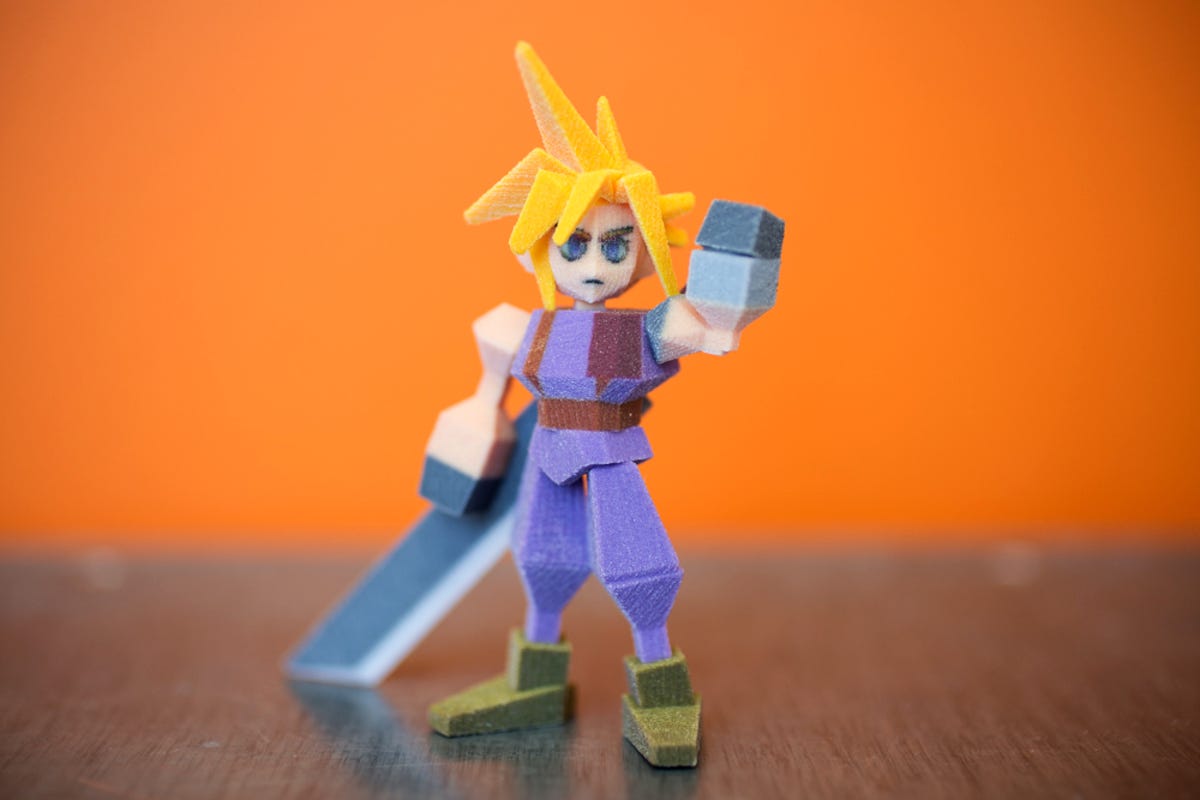3D-printed figures fire up fans, rankle a rights owner (pictures)
Final Fantasy VII was the first in the popular series of role-playing games to use 3D graphics -- way back in 1998. And Joaquin Baldwin's 3D-printed figures play off that original low-fi look to great effect.

3D-printed Cloud figure
This Cloud figure was produced on Shapeways' $60,000 Z-Corp 3D printer and cost $19 to purchase. Thanks to the immense publicity initially generated by Reddit's gaming community, Final Fantasy publisher Square Enix pulled the plug on digital artist Joaquin Baldwin's operation.
The original low-fi graphics of FFVII
Released in 1998 for the original PlayStation, Final Fantasy VII was the first Final Fantasy game to feature 3D graphics, a milestone for the role-playing series. The screenshot here shows the game at its base level, while combat and cut-scenes exhibited far superior graphics that were used sparingly because of the memory and hardware constraints of the era.
Though groundbreaking for its time, the crude polygon look of the character sprites, as they're called, now seems laughable compared with modern gaming graphics. But digital artist Joaquin Baldwin found the look to be appealing for its nostalgic value, and sought to re-create the models with his 3D-printed figures.
"It is the most memorable game I've ever played. A lot of fans probably feel that same way," Baldwin said.
Baldwin's personal set
Shapeways, the marketplace for user-designed 3D-printed objects, complied with Square Enix's takedown notice, but Baldwin -- a longtime fan who considers FFVII the most memorable game he's ever played -- still has a complete set of the figures that he keeps on his desk at work.
"I'm very proud of them, it's something I always wanted, but I'm sad that a lot of people got excited about them and won't be able to get [a set] of their own," he said.
Square Enix's high-end action figure
Part of the reason Square Enix might not want anyone making low-cost versions of its characters -- besides the obvious copyright infringement -- is that the company manufacturers its own line of expensive collectible action figures that, like the one above, often sell for well over $100 dollars.
The $60 3D-printed figure no one bought
After completing the set of main characters that sold for between $14 and $30, Baldwin did a test run on making one of the game's many summonable deities. In this case, he chose the Norse god Odin, even designing him on horseback.
The cost, however, was set at $60 dollars. "He's so big that it was impossibly expensive and no one wanted to buy one," Baldwin said.
The graphical upscale in FFVII
Because of the hardware constraints of the era, Square Enix wasn't able to achieve an even distribution of the otherwise groundbreaking 3D graphics in its 1998 Final Fantasy release.
That meant that only during in-game combat (a core component of the title, separate from exploration and regular plot cut-scenes) were the graphics slightly better than the "low-poly" style Baldwin emulated with his 3D-printed figures.
The evolution of FFVII
After four additional spinoff games, bridging multiple platforms; several releases and rereleases of original animated films; and a series of short stories, Square Enix had turned its classic role-playing game into a sprawling ecosystem.
That meant the characters -- and how Square Enix wanted them envisioned -- evolved with the times. Seen here in a scene from the 2005 computer-animated film "Advent Children" are the game's main character, Cloud, and the antagonist, Sephiroth, realistically rendered far-cries from their 1998 counterparts.
The complete collection
Owing to the popularity of his initial set of figures, Baldwin went ahead and created nearly every other character in the game, compiling a full-blown collection, which catapulted his Shapeways creations to Internet stardom.
"I only made that whole set recently, and I posted the full new set of secondary characters two days ago, when I guess I exploded the Internet," he said. Apparently, exploding the Internet also tipped off Square Enix, which quickly sent a takedown notice to the Shapeways marketplace to prevent further sales.
The ZPrinter 650
This $60,000 color 3D printer, produced by Z Corporation, is a massively capable device that can produce everything from camcorders, shown above, to frequency counters.
Shapeways, the Dutch-founded and New York-based company that Joaquin Baldwin used to produce his figures, has one of these printers in its Long Island City warehouse. On submitting computer-generated models to Shapeways, any artist can have the ZPrinter 650 produce his or her desired product and can sell it by way of the company's marketplace.

